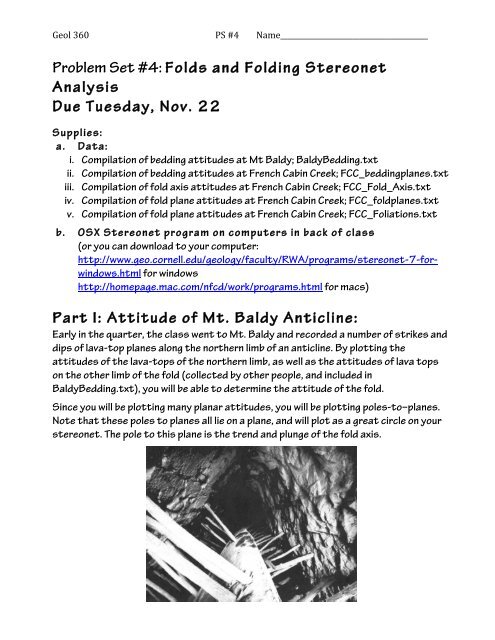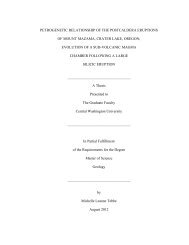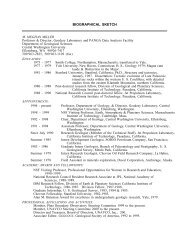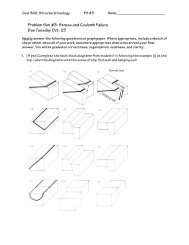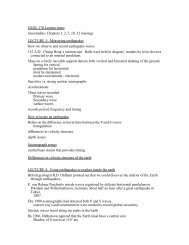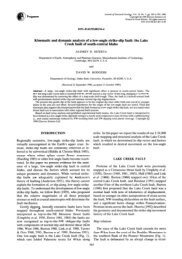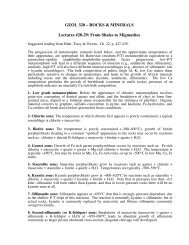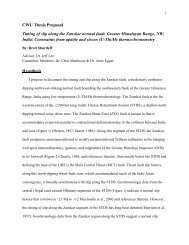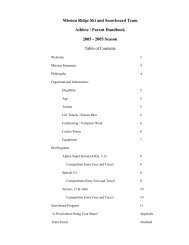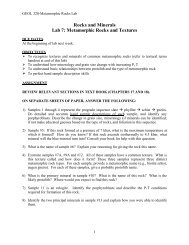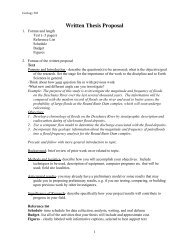Problem Set #4: Folds and Folding Stereonet Analysis Due Tuesday ...
Problem Set #4: Folds and Folding Stereonet Analysis Due Tuesday ...
Problem Set #4: Folds and Folding Stereonet Analysis Due Tuesday ...
Create successful ePaper yourself
Turn your PDF publications into a flip-book with our unique Google optimized e-Paper software.
Geol 360 PS <strong>#4</strong> Name_________________________________________ <strong>Problem</strong> <strong>Set</strong> <strong>#4</strong>: <strong>Folds</strong> <strong>and</strong> <strong>Folding</strong> <strong>Stereonet</strong><strong>Analysis</strong><strong>Due</strong> <strong>Tuesday</strong>, Nov. 22Supplies:a. Data:i. Compilation of bedding attitudes at Mt Baldy; BaldyBedding.txtii. Compilation of bedding attitudes at French Cabin Creek; FCC_beddingplanes.txtiii. Compilation of fold axis attitudes at French Cabin Creek; FCC_Fold_Axis.txtiv. Compilation of fold plane attitudes at French Cabin Creek; FCC_foldplanes.txtv. Compilation of fold plane attitudes at French Cabin Creek; FCC_Foliations.txtb. OSX <strong>Stereonet</strong> program on computers in back of class(or you can download to your computer:http://www.geo.cornell.edu/geology/faculty/RWA/programs/stereonet-7-forwindows.htmlfor windowshttp://homepage.mac.com/nfcd/work/programs.html for macs)Part I: Attitude of Mt. Baldy Anticline:Early in the quarter, the class went to Mt. Baldy <strong>and</strong> recorded a number of strikes <strong>and</strong>dips of lava-top planes along the northern limb of an anticline. By plotting theattitudes of the lava-tops of the northern limb, as well as the attitudes of lava topson the other limb of the fold (collected by other people, <strong>and</strong> included inBaldyBedding.txt), you will be able to determine the attitude of the fold.Since you will be plotting many planar attitudes, you will be plotting poles-to–planes.Note that these poles to planes all lie on a plane, <strong>and</strong> will plot as a great circle on yourstereonet. The pole to this plane is the trend <strong>and</strong> plunge of the fold axis.
them. What is this interlimb angle ? ______________b) Mark the point half way between the poles along the great circle connectingthem (this is the fold bisector). Fit a great circle to fold bisector <strong>and</strong> the foldaxis. This plane approximates the axial surface for folds that are not tooasymmetric.What is the strike <strong>and</strong> dip of the axial surface of the fold?____________________c) Using your field map <strong>and</strong> analysis , make an accurate geologic cross section ofthe Baldy structure. Do not make a topographic profile, just draw the structuralcross-section to scale. Keep the horizontal <strong>and</strong> vertical scale the same.d) Lastly, describe the type of fold you mapped (your description should usealmost all of the words covered in class)Part II: Attitude of <strong>Folds</strong> in the Cascades:Just a few weeks ago, the class went the Cascades, near French Cabin Creek,<strong>and</strong> recorded a number of strikes <strong>and</strong> dips of folded meta-sedimentary rocks, as wellas attitudes of fold axis <strong>and</strong> axial surfaces.The present day structure of the Washington Cascades is dominated by abroad, deeply eroded north-south anticlinorium. This young structure upwarps asystem of older, tighter, northwest-southeast folds <strong>and</strong> faults (part of the systemthat formed the Mt Baldy anticline).In this part of the problem you will determine the present-day attitude of foldsin the French Cabin Creek region of the Cascades. By comparing the attitude of thesemultiply deformed folds to the attitude of the Mt Baldy fold, we will be able to talkabout the younger event.1) Finding the fold axis of folds in the French Cabin Creek region:plotting dataa) Using the stereonet program, Plot all the bedding attitudes as POLES TOPLANES. Fit a great circle to your data.What is the attitude of this great circle? _________________________c) Plot the pole to this great circle <strong>and</strong> mark it prominently with a "+".What is the attitude of this pole? _________________________
d) What is the estimated orientation of the fold axis ?____________________________e) Using the stereonet program, plot the attitudes of the fold axis that weretaken in the field. Contour these. What is the attitude of the best-fit field-foldaxis? _____________________________________How close are the field attitudes <strong>and</strong> the calculated attitude for the fold axis?2) Finding the best estimate of attitude of the fold limbs <strong>and</strong> the axialplane.We never really got to see the other limb of the macroscopic fold, so we can’t justlook for high density attitudes on the stereonet to find the two limbs. However, bylooking at the poles-to-bedding, you may get a hint of two limbs. As a buddinggeologist, you’re willing to test the idea that you can, in fact, use the poles tobedding to estimate the axial plane.a) Given that we were able to take only a couple strikes <strong>and</strong> dips of northern limbs(of mesoscopic folds)- what do you think are the attitudes of the two poles tolimbs?____________________________b) What are the attitudes of the two limbs?__________________________c) Now fit a great circle to the two fold-limb-poles, <strong>and</strong> count the angle betweenthem. What is this interlimb angle ?___________d) Mark the point half way between the limb-poles along the great circle connectingthem (this is the fold bisector). Fit a great circle to fold bisector <strong>and</strong> the foldaxis. This plane could approximate the axial surface of the fold.What is the strike <strong>and</strong> dip of the axial surface of the fold?____________________
3) Another way to get a h<strong>and</strong>le on the axial plane.a) Plot the pole to the axial surface that you determined is step 2Now plot the poles to fold planes that were measured in the field, <strong>and</strong> the polesto bedding.Notice that all of these poles fall near a great circle- thus they all have about thesame strike, but just have different dips. Draw a great circle through the clusterof poles. Now, determine the pole to the circle. The trend of the pole is theapproximate strike of all these planes. What is the average strike of themeasured fold planes? ____________________What is the range of dips of the fold planes? _____________________b) Now, look at the attitude of the axial plane you determined in part 2 above. Dothe two attitudes match? Why or why not?If not, rethink step c-d above, <strong>and</strong> recognize that there are two interlimb angles.Now, redo steps c-d, using the other interlimb angle. What is the new calculatedattitude of the axial plane?______________________________c) Looking at your plot of poles to bedding, <strong>and</strong> poles to the fold planes, again seehow they all fall near a great circle, they are all just planes with different dips.Now, try to visualize parasitic folds on a larger fold, imagine how the axial planesof these parasitic folds could have the same strike, but different dips. Try <strong>and</strong>draw a picture of this.b) Now make another plot with all of the above poles, <strong>and</strong> add the poles to foliation.Knowing the relationship between foliation of fold planes, make another sketchshowing the attitudes of parasitic folds, fold axis, <strong>and</strong> foliation.Part III: Describing the most recent folding in theCascadesThe attitude of the Mt Baldy fold is somewhat representative of folds formed inthe Neogene. This period of folding affected rocks throughout the region, includingrocks in the Cascades.Subsequently, another folding event has affected the rocks in the Cascades. By
ecognizing the pole of rotation between the two folds, we can describe the secondstage of foldinga) plot the pole to the Mt Baldy axial plane, <strong>and</strong> the range of poles to the axialplanes in the French Cabin Creek area.b) What is the rotation axis that best rotates the older fold attitude intothe younger fold attitude? _____________________________c) How much rotation occurred? Was it clockwise, or counterclockwise?(looking down the rotation axis)_______________________________d) Given the young age of this second folding event (just a few million yearsago), what regional tectonics could be responsible for the folding?


